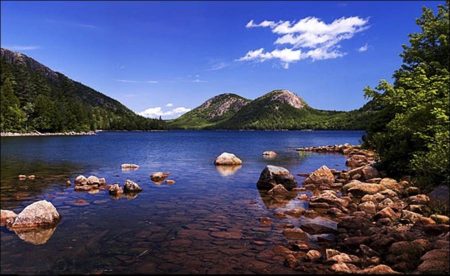Among the many colorful episodes that marked the westward sweep of civilization across the American continent, one of the most dramatic and significant was the exploration and settlement of the Ohio country. The term, Ohio country, may be defined as approximately that area, bounded by the Ohio and Allegheny rivers on the east and the south, by Lake Erie and the Maumee Valley on the north, and by the Miami and Auglaize valleys on the west. With certain minor adjustments of these boundaries, the Ohio country developed from a primitive wilderness into the State of Ohio with its 40,740 square miles.
In the course of this notable transformation many important influences were at work which determined the future of the Ohio country itself, and had a profound effect as well upon the progress of the American nation. Indeed, aside from the particular advantages it held out to the would-be settler, the Ohio region was a veritable gateway between the expanding population east of the Appalachians, and the vast stretches of vacant land in Indiana, Illinois, Michigan, Wisconsin, and across the Mississippi.
In the stupendous cavalcade of the Ohio country, first came the aboriginal inhabitants, the all but mythical Mound-builders, and then the Indians. Not until the seventeenth century did Europeans find their way here in the persons of the French fur traders and missionaries, who had pushed westward from their settlements in Canada along the St. Lawrence. Exploring the southern shore of Lake Erie, and the Ohio Valley, probably as far as the Falls at Louisville, they marked out first the bare outlines of the Ohio region.
Meanwhile the English were absorbed in their far-flung task of occupying and developing the Atlantic Coast, and only a few exceptionally hardy adventurers penetrated the Appalachian barrier, and fewer still, if any, crossed over the Ohio River into the fertile lands beyond. To the English colonists of the seventeenth century, therefore, the Ohio country with the great river that bordered it, remained a shadowy region regarding which they had picked up a few scraps of information from the Indians, and in roundabout fashion from the French in Canada.
In the eighteenth century the situation changed completely, and the English, as well as the French, developed an increasing appreciation of the Ohio country which finally brought about a life and death struggle for its possession. The French, extending their explorations and incidentally their fur trade, built up a considerable commerce on Lake Erie, and penetrated the Ohio country itself from the north. From the east and the south, the English explorers and fur traders, grown bolder, were now crossing the Appalachians, and entering this same region in increasing numbers. Both English and French endeavored to gain the friendship of the sparse Indian population, in order to control the fur trade. Finally the struggle between the two nations broke out in open conflict, and the English gained a complete victory, ousting the French in 1763.
Then came the two-fold British problem of controlling the Indians, and at the same time holding back the American colonists who were impatient to press onto the rich lands that lay beyond the Ohio. Finally came the American Revolution, and the English, in turn, were supposedly ousted. But for a while the question of ultimate control hung in the balance, until the American Government worked out a colonial policy which attracted a sturdy population, and thus held the Ohio lands in spite of British intrigues.
Of equal significance, the American civilization which these pioneers developed became a pattern for succeeding frontier areas, as the United States spread westward. Finally, upon the foundations which had been laid in the seventeenth and eighteenth centuries, the State of Ohio was established in 1803. The progress of this epic development of the Ohio country, from the primitive wilderness until the State of Ohio emerged, will form the central theme of this present volume.
Geographically the most outstanding feature of the Ohio country was the Ohio River, which has appropriately given this region its name. The origin of the word, “Ohio,” has been the subject of considerable controversy. The most plausible explanation is, that it is merely the English form of an Iroquoian word which in the Mohawk and Cayugan dialects became, O-hē-yo, meaning “Great River.” This name, it has been asserted, the Iroquois gave to the stream which, according to the tradition among the Five Nations, originated in their country in the present-day Allegheny, and from there flowed down on its long course to the Mississippi. The French, however, from the earliest discovery dubbed this same stream La Belle Rivière, “The Beautiful River.”
Hence arose the explanation which was commonly accepted for so many years, that “Ohio” signifies “Beautiful River.” There is a possibility that the French made a mistake in translating the Iroquoian word, but it is much more probable that, with their keen sense of beauty, it was on their own initiative that they gave the stream so fitting a name as La Belle Rivière. This theory is strikingly supported by Franquelin’s Map of North America, published in 1681, which labels the river west of the Appalachians, which the French had only lately explored, La Belle Rivière ou Oü-i-o. These alternative names appeared frequently in later maps, and doubtless the English, instead of literally translating the French as the rather prosaic “Beautiful River,” preferred the far more poetic Iroquoian name, which they translated, “Ohio.”
Visits: 117



